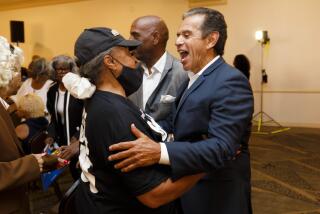Rodriguez: Demographics isn’t destiny
Eight years ago, after former California Assembly Speaker Bob Hertzberg was knocked out of the L.A. mayor’s race in the primary, urban critic Joel Kotkin and political consultant Arnie Steinberg bravely predicted that the chances of a Jew ever being elected to the mayoralty had been greatly diminished.
They agreed that the demographic writing was on the wall. The “growing dominance of Los Angeles by Latino politicians and public employee unions” and the diminishing Jewish percentage of the Los Angeles electorate were “limiting the options for Jewish politicians.”
Even the briefest glance at the major 2013 mayoral candidates should convince you of how deeply wrong those gentlemen were. Right now, I’d put the chances that the next mayor of Los Angeles will be intimately tied to Jewishness or Judaism by blood, conversion or marriage at about, um, 100%. Eric Garcetti is Mexican Italian Jewish. Jan Perry is an African American who converted to Judaism 30 years ago. Wendy Gruel is married to a Jewish man and is raising her son in her husband’s faith.
Kotkin and Steinberg weren’t the only ones to misread the long-term ethnic significance of Antonio Villaraigosa’s election in 2005. Four years earlier, labor leader Miguel Contreras had suggested out loud what so many other civic observers just assumed: that James Hahn, who was elected in 2001, would be the last white mayor of Los Angeles.
There’s no doubt that Villaraigosa’s victory in 2005 was a historic milestone. His election signaled that Latinos at last had a seat at the table politically and were becoming more socially integrated. It marked a new era, as L.A.’s Mexican Americans got to experience the political coming-of-age that so many other ethnic groups achieved in a variety of U.S. cities before them.
But somewhere in the all the hoopla we mistook the milestone for the end of the road. We wrongly thought that the political emergence of Latinos was a juggernaut that would eclipse all other comers in a zero-sum game.
We should have known better than to think that demography was destiny. After all, blacks never made up a large percentage of Angelenos, and we had an African American mayor, Tom Bradley, for 20 years (and two black police chiefs). Likewise, since the 1970s Jewish politicians have played a role in the city’s civic life that has belied their numbers in the population. In the 1990s, L.A. had half a dozen Jewish state Assembly members. In 2010, Southern California elected seven Jewish politicians to Congress.
The election of a Mexican American mayor in L.A. didn’t so much signal the end of the process of fully including Latinos in the city’s establishment as its beginning.
And the more important issue may be what happens outside City Hall. Constant demographic change requires ongoing efforts to integrate the new with the long established. A healthy society is an inclusive one, a place where a broad cross-section of stakeholders feels represented at the highest levels. Politics is certainly one means of inclusion. But it’s not the only one.
Look around, and except in the Catholic Archdiocese, there are too few local Latinos at the helm and even the mid-level of the city’s major institutions. One head of a philanthropic foundation. No heads of museums or universities. No Latino surnames on the current masthead of this paper. And never a Mexican American police chief.
L.A.’s civic elites bemoan the city’s embarrassingly low rates of engagement and political participation. But other than fretting about what the region’s ongoing demographic change will mean for their hold on power, it’s not clear what they are doing to make the broadest cross-section of Los Angeles feel like part of the city’s civic life.
Villaraigosa’s mayoralty has been a significant moment in the history of modern Los Angeles. But it can’t be a substitute for a concerted effort to integrate the city’s social and cultural life. Remember that word “integration”?
So, no matter what the next mayor’s background turns out to be, the need to bring the many disparate parts of the city together remains the same. Making Los Angeles’ institutions look like L.A. is not just about symbolism, politics or the mayoralty. We’ll never be a great city if native-born members of the emerging majority can’t imagine themselves growing up to one day become — not just a breakthrough mayor — but its everyday, year-in-year-out movers and shakers.
grodriguez@latimescolumnists.com
More to Read
A cure for the common opinion
Get thought-provoking perspectives with our weekly newsletter.
You may occasionally receive promotional content from the Los Angeles Times.










